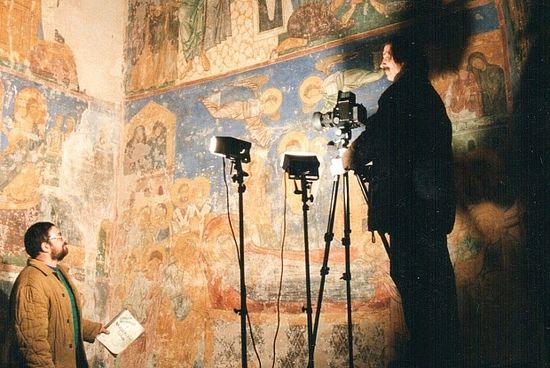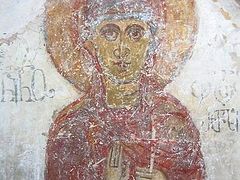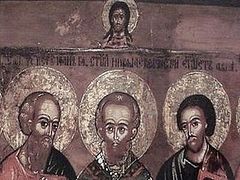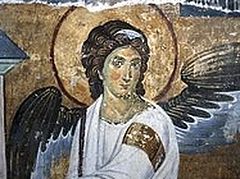Source: The Art Newspaper
March 22, 2016
 Russia’s chief restorer of ancient religious frescoes Vladimir Sarabyanov at work (on the left). Sarabyanov died in 2015
Russia’s chief restorer of ancient religious frescoes Vladimir Sarabyanov at work (on the left). Sarabyanov died in 2015
After nearly a year of uncertainty, the Russian government has decided against its controversial plan to fold the Interregional Art Restoration Center in Moscow (MNRHU), one of the country’s premier studios and the only one specialising in ancient Russian frescoes, into a giant commercial restoration firm created by the government.
The decision comes several months after an open letter protesting against the move was written to the Russian president, Vladimir Putin, by the family and colleagues of Vladimir Sarabyanov, the institution’s former deputy head and Russia’s chief restorer of ancient religious frescoes, who died in 2015 at the age of 56. The concern was that the merger would result in a dilution of specialist skills that would put the country’s Russian Orthodox monuments at risk.
Government protection
In a written response to The Art Newspaper, dated 9 February, Russia’s culture ministry stated that it had decided to preserve the status of MNRHU as an independent legal entity and was working towards “including the enterprise in the list of the Russian Federation’s strategic enterprises”, a designation that enables government protection and allows access to preferential state financing. It also means that “people without special education, qualifications and knowledge” will not be able to participate in the tender process, says Yevgenia Seryogina of the MNRHU.
For now, although MNRHU is the only institution with expertise in ancient Russian frescoes, it is required by law to tender for restoration projects that are ultimately won by the lowest bidders, regardless of their expertise.
Sarabyanov, also an art historian who came from a long line of art historians, died last April, as the government’s plans emerged to create a restoration superstructure called Restoration Companies—a public limited company that would incorporate MNRHU and several other restoration entities. In their appeal to Putin last June, Sarabyanov’s family and colleagues, along with other specialists, wrote: “The loss of MNRHU is a real threat to the preservation of our country’s earliest artistic heritage.”
Restorers remain wary
The ministry, having consulted various experts, now says that MNRHU will not fully merge with Restoration Companies, but will instead work with the company on large projects, and that its “broader profile” will enable it to “significantly improve economic indicators”. Restorers remain wary, as their sector now answers to Rosimushchestvo, the Federal Agency for State Property Management. Some fear that restoration institutions occupying prime real estate in Moscow, such as MNRHU, will be pushed out.
Within MNRHU, Sarabyanov, who sat on the Presidential Council for Culture and Art, is still very much alive. His portrait hangs over his desk, and photographs of the monuments on which he worked line the walls. A specialist in ancient Russian frescoes, he was described by colleagues as “a Russian Leonardo da Vinci”. His expertise was vital in restoring monuments ranging from cathedrals within the Kremlin to the Mirozhsky and Snetogorsky monasteries in Pskov, the Yuriev Monastery in Novgorod and the Dormition Cathedral in Vladimir.
Key figure
“Sarabyanov is probably the most outstanding figure in the history of the study of art and in the sphere of restoration of the 20th century,” says Natalia Sheredega, the head of the department of ancient Russian art at the State Tretyakov Gallery in Moscow. “He was outstanding not only for his incredible level of talent, but because he was able to unite his theoretical ideas in practice and translate the principles of scientific restoration into real work.”
In 2012, Sarabyanov’s work on the St Euphrosyne Monastery in Polotsk, in Belarus, uncovered 12th-century frescoes that were probably painted by Greek artists and are, by his estimation, unlike any others in the Russian Orthodox Church in terms of style and content. He had also worked on the restoration of Paleolithic cave murals in the Urals and, at the time of his death, was in the process of restoring Medieval Byzantine frescoes in Edde, Lebanon.
Holistic approach
Polina Tychinskaya, a young restorer at MNRHU, says that Sarabyanov was interested in more than just paintings. “He always participated in discussions about an integrated approach to monument restoration projects. Frescoes are inseparably linked to architecture,” she says.
It is work that requires monastic devotion in Russia. As the ruble falls, restorers’ salaries at MNRHU amount to an average of $300 a month (if they are paid at all, since they depend on tenders). Sarabyanov’s work showed that nothing is comparable to original objects, which are “living witnesses to the antiquity of our culture” and its role in the Byzantine world, Tychinskaya says. He was trying to save Russian cultural monuments from extinction brought on both by the overall lack of money and too much money allocated to select restoration projects in which delusions of grandeur trump authenticity. Russia’s ancient monuments have, yet again, become hostages to ideology, but Sarabyanov was gathering them together in his own Noah’s Ark.
“He was passionately committed to saving what is left of our national culture,” Sheredega says. “Of course, a restorer is more than a restorer in Russia. They are unique individuals who tangibly ground us in this world by preserving that which can be the only foundation for national identity; for undistorted national identity.”



